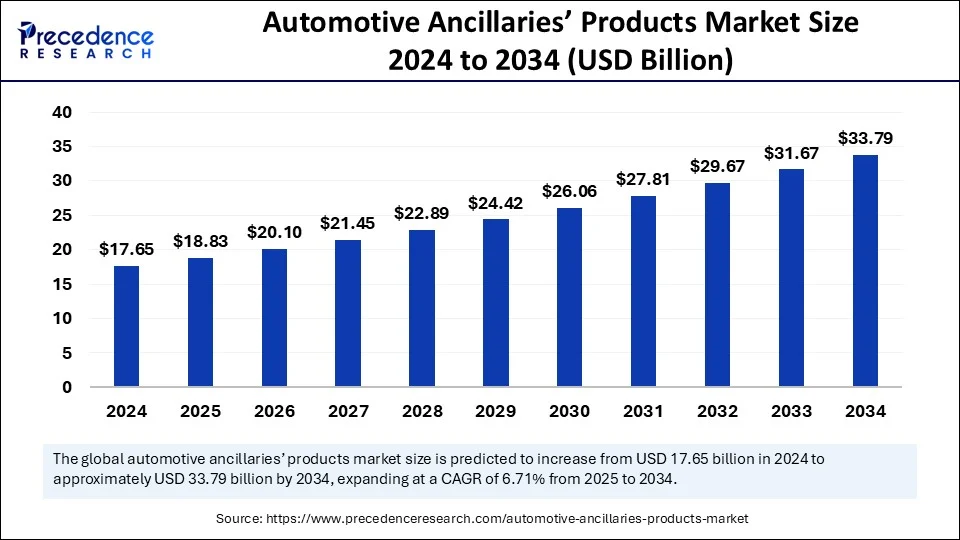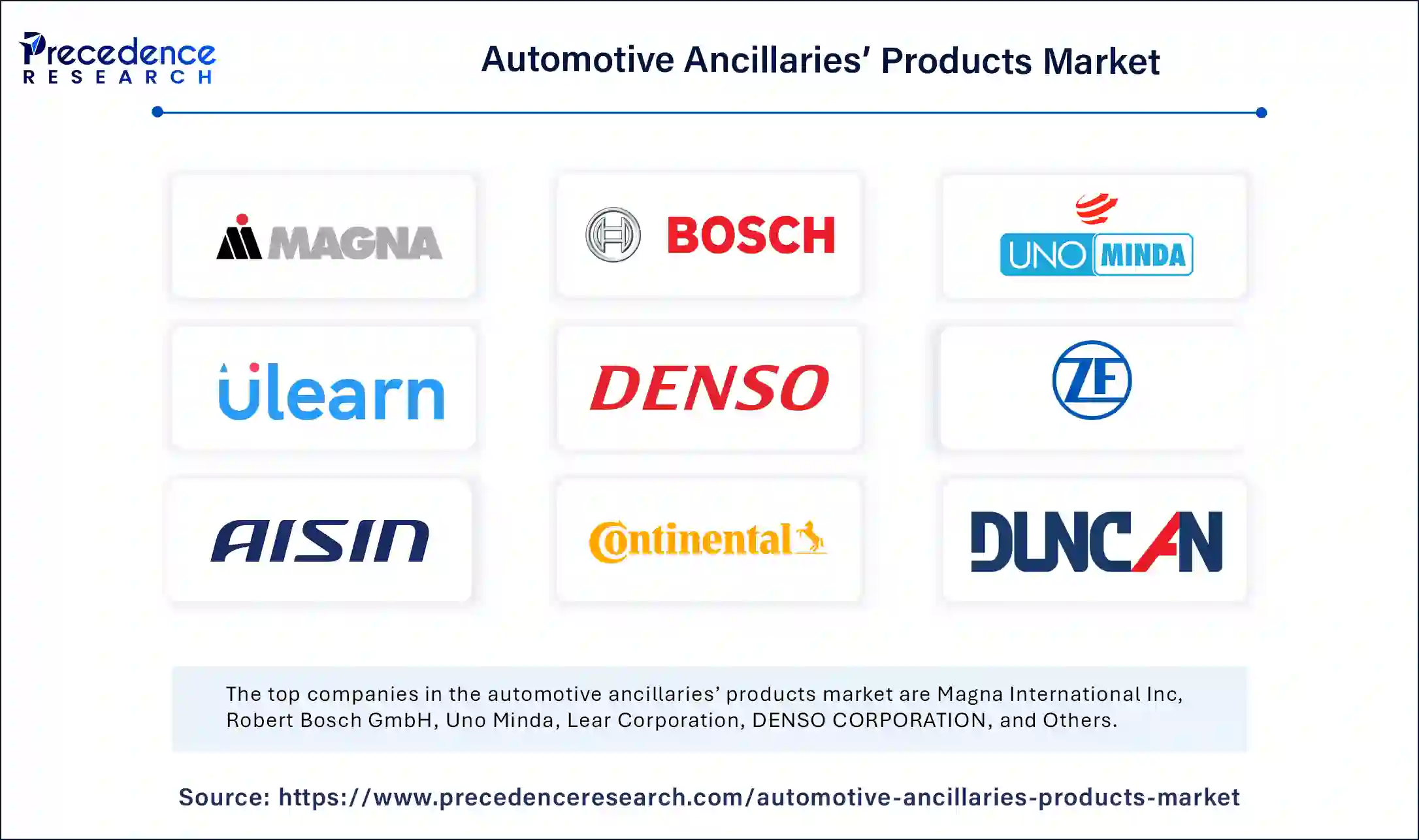The global automotive ancillaries’ products market size was estimated at USD 17.65 billion in 2024 and is expected to attain around USD 33.79 billion by 2034, growing at a CAGR of 6.71%.

Automotive Ancillaries’ Products Market Key Highlights
-
Asia Pacific led the automotive ancillaries’ products market in 2024, holding the largest share of 39%.
-
North America is expected to register the fastest CAGR throughout the forecast period.
-
The engine, transmission, and suspension components segment held the largest market share by component in 2024.
-
The electrical parts segment is projected to grow at the highest rate during the forecast period.
-
Passenger vehicles dominated the market by application, accounting for 73% of the share in 2024.
-
The commercial vehicle segment is forecasted to experience significant growth in the coming years.
-
The aftermarket distribution channel captured the largest market share of 75% in 2024.
-
The OEM distribution channel is anticipated to witness substantial growth during the forecast period.
The Automotive Ancillaries’ Products Market is experiencing robust growth driven primarily by the increasing demand for vehicles worldwide, particularly in emerging economies. Rising disposable incomes and urbanization have led to a surge in vehicle ownership, which in turn fuels the need for a wide range of ancillary products such as engine components, suspension parts, electrical systems, and more. Additionally, the ongoing shift toward electric vehicles (EVs) is creating new opportunities for automotive ancillary manufacturers to innovate and supply components specific to EVs, such as battery management systems and advanced electrical parts, further expanding the market.
Another important growth factor is the rapid technological advancement and integration of smart systems in vehicles. Modern vehicles are increasingly equipped with sophisticated safety features, infotainment systems, and advanced driver assistance systems (ADAS), all of which rely heavily on ancillary products. This trend is pushing manufacturers to develop high-precision, reliable components, thereby driving market expansion. Moreover, the automotive industry’s focus on lightweight and fuel-efficient vehicles has increased demand for specialized ancillary parts made from advanced materials, contributing to market growth.
Global supply chain improvements and increased investments in manufacturing infrastructure are also playing a significant role. Countries with strong automotive manufacturing bases, particularly in Asia Pacific, are attracting more investments in ancillary product production due to cost advantages and skilled labor availability. This regional growth is complemented by growing aftermarket services and vehicle maintenance needs, which sustain the demand for replacement parts and components, ensuring steady market momentum.
Lastly, stringent government regulations on vehicle emissions and safety standards are encouraging manufacturers to upgrade or replace existing vehicle components with higher-quality, compliant ancillary products. This regulatory environment stimulates innovation and quality improvements in ancillary products, which is positively impacting market growth by fostering a cycle of continuous demand and development.
Get this report to explore global market size, share, CAGR, and trends, featuring detailed segmental analysis and an insightful competitive landscape overview@ https://www.precedenceresearch.com/sample/5890
Role of AI in Automotive Ancillaries’ Products Market
Artificial Intelligence (AI) is transforming the automotive ancillaries’ products market by enhancing product design, manufacturing processes, and supply chain management. AI-powered analytics help manufacturers predict demand, optimize inventory, and improve quality control, leading to reduced costs and increased efficiency. In production, AI-driven automation and robotics enable precise assembly and testing of components, ensuring higher reliability and consistency.
Moreover, AI facilitates the development of smart and connected automotive parts, such as advanced sensors and electronic control units that improve vehicle safety and performance. By integrating AI technologies, automotive ancillaries can support the growing demand for electric vehicles (EVs) and autonomous driving systems, making the market more innovative and competitive.
Automotive Ancillaries’ Products Market Scope
| Report Coverage | Details |
| Market Size by 2034 | USD 33.79 Billion |
| Market Size in 2025 | USD 18.83 Billion |
| Market Size in 2024 | USD 17.65 Billion |
| Market Growth Rate from 2025 to 2034 | CAGR of 6.71% |
| Dominated Region | Asia Pacific |
| Fastest Growing Market | North America |
| Base Year | 2024 |
| Forecast Period | 2025 to 2034 |
| Segments Covered | Component, Application, Distribution Channel, and Regions |
| Regions Covered | North America, Europe, Asia-Pacific, Latin America and Middle East & Africa |
Automotive Ancillaries’ Products Market Dynamics
Market Drivers:
The automotive ancillaries’ products market is experiencing robust growth fueled by the increasing production and sales of vehicles globally, especially in emerging economies. Rapid urbanization, rising disposable incomes, and growing consumer preference for personal mobility have led to heightened demand for passenger and commercial vehicles, which in turn drives demand for automotive ancillary products such as components, spare parts, tires, batteries, and electronic systems. Additionally, the rising trend of vehicle customization and aftermarket services has propelled the need for ancillary products that enhance vehicle performance, safety, and aesthetics.
The shift toward electric vehicles (EVs) and hybrid vehicles is also influencing the market by stimulating demand for new types of ancillary components such as battery management systems, electric motors, and lightweight materials. Furthermore, stringent government regulations on vehicle safety and emissions standards are encouraging manufacturers to upgrade and innovate their ancillary product lines, creating a steady market momentum.
Market Opportunities:
The automotive ancillaries market offers vast opportunities, particularly in the context of technological innovation and evolving vehicle designs. The rapid adoption of electric and autonomous vehicles is creating demand for specialized ancillary components including advanced sensors, electric powertrain parts, and smart electronics. Ancillary manufacturers who invest in research and development to develop lightweight, durable, and eco-friendly components stand to gain a competitive advantage. Additionally, the expanding aftermarket for vehicle maintenance and repair, driven by the rising average age of vehicles on the road, presents a significant growth avenue.
Geographic expansion into emerging markets such as India, China, and Southeast Asia, where vehicle ownership is on the rise, is another critical opportunity. The increasing trend of vehicle customization and personalization in these regions also fuels demand for aftermarket ancillary products. Furthermore, collaborations between original equipment manufacturers (OEMs) and ancillary suppliers to integrate next-generation technologies offer pathways for growth and innovation.
Market Challenges:
Despite the positive outlook, the automotive ancillaries market faces a range of challenges. Intense competition among global and regional suppliers leads to pricing pressures and shrinking profit margins, making it difficult for smaller players to sustain. The transition to electric vehicles presents technological challenges for traditional ancillary manufacturers who must adapt to new components and production processes, requiring substantial capital investment and technical expertise. Supply chain disruptions, such as those caused by geopolitical tensions, raw material shortages, and logistics constraints, also hamper production schedules and cost efficiencies.
Additionally, strict regulatory compliance related to quality, safety, and environmental standards imposes operational complexities and increased costs. The growing demand for customization and faster product development cycles further stresses manufacturers’ capabilities. Finally, fluctuating raw material prices, especially metals and polymers, add an element of unpredictability to manufacturing costs.
Regional Outlook:
Asia Pacific dominates the automotive ancillaries market, driven primarily by countries such as China, India, Japan, and South Korea, which are major hubs for vehicle manufacturing and component production. The region benefits from a large skilled workforce, competitive manufacturing costs, and growing domestic vehicle demand. North America and Europe also hold significant shares, supported by advanced automotive technologies, stringent regulatory frameworks, and high aftermarket demand. Europe, in particular, is a leader in adopting green technologies and sustainable manufacturing practices, influencing ancillary product trends.
The North American market is buoyed by strong automotive OEM presence and robust aftermarket services. Latin America and the Middle East & Africa are emerging markets with increasing vehicle sales and infrastructure development, although growth is somewhat constrained by economic volatility and lower consumer purchasing power. Nevertheless, ongoing investments in road infrastructure and rising awareness about vehicle maintenance are expected to progressively boost ancillary product demand in these regions.
Automotive Ancillaries’ Products Market Companies

- Magna International Inc
- Robert Bosch GmbH
- Uno Minda
- Lear Corporation
- DENSO CORPORATION
- ZF Friedrichshafen AG
- AISIN CORPORATION
- Continental AG
- Duncan Engineering Ltd
- Nippon
Segments Covered in the Report
By Component
- Engine Transmission and Suspension Components
- Electrical Parts
- Sheet Metal Parts and Body and Chassis
- Cleaning, Maintenance, and Repair of Products
- Others
By Application
- Commercial Vehicle
- Passenger Vehicle
By Distribution Channel
- OEM
- Aftermarket
By Region
- North America
- Asia Pacific
- Europe
- Latin America
- Middle East and Africa
Also Read: Off-Highway Vehicle Lighting Market
Source: https://www.precedenceresearch.com/automotive-ancillaries-products-market
